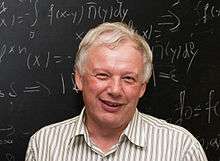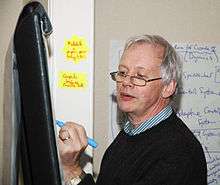David Broomhead
| Dave Broomhead | |
|---|---|
 Broomhead in 2008 | |
| Born |
David S. Broomhead 13 November 1950 Leeds, United Kingdom |
| Died |
24 July 2014 (aged 63) London, United Kingdom |
| Residence | |
| Citizenship | United Kingdom |
| Fields | Mathematics |
| Institutions | |
| Alma mater | University of Oxford |
| Thesis | Molecules in Electromagnetic Fields (1976) |
| Doctoral advisor | Peter Atkins |
| Doctoral students | |
|
Website www | |
David S. Broomhead (13 November 1950 – 24 July 2014) was a British mathematician specialising in dynamical systems and was professor of applied mathematics at the School of Mathematics, University of Manchester.[7][8]
Education
Broomhead was born on 13 November 1950 in Leeds. He attended Aireborough Grammar School and, after spending a year teaching in Uganda, Broomhead moved to Merton College, Oxford, where he read chemistry for his first degree. He remained in Oxford for his D.Phil., researching quantum mechanics under the supervision of Peter Atkins. He completed his thesis Molecules in Electromagnetic Fields in 1976.[7][9]
Career
After a year as a postdoc at the Atomic Energy Research Establishment, Broomhead moved to Japan. He held at two-year NATO Postdoctoral Fellowship in the Department of Physics at the University of Kyoto, in K. Tomita’s group. On returning to the U.K., he worked as a postdoc with George Rowlands at the University of Warwick, again in the Physics Department. In 1983, Broomhead began working in the Signal Processing group at the Royal Signals and Radar Establishment (RSRE, now QinetiQ) in Malvern, becoming Senior Principal Scientific Officer. In 1995 he moved to Manchester, taking a Chair in Applied Mathematics, initially at UMIST and then after 2004, at the School of Mathematics at the new University of Manchester.[7][9][10]
From 1989 to 1992 he was Coordinator of the EPSRC Nonlinear Mathematics Initiative. He held visiting positions at University College London, the University of Oxford and Hiroshima University. Broomhead was a Fellow of the Institute of Mathematics and its Applications (IMA), a member of the IMA Council from 1998 and was Chair of the Editorial Board of Mathematics Today from 2002.[9] In 2013 he was made an Honorary Fellow of the IMA.[7]
Research

Broomhead's main interest was the development of methods for time series analysis and nonlinear signal processing using techniques from the theory of nonlinear dynamical systems.[11][12][13][14] He also championed applying these ideas in interdisciplinary research.[15][16][17]
In Japan, Broomhead began to work seriously on applied nonlinear dynamics and chaos. With Greg King he developed techniques to determine whether an experimental time series had been generated by a deterministic chaotic system by combining the pure mathematical results on topological embedding due to Takens with the engineering method of singular value decompositions.[7][9]
While in Malvern, Broomhead wrote his influential papers on delay embedding and on neural networks. In 1989 he was awarded the John Benjamin Memorial Prize for work with David Lowe and Andrew Webb that exploited an analogy between neural networks and interpolation using the newly developed radial basis functions from numerical analysis.[7][9]
At Manchester he became increasingly interested in applications to biology. He worked initially on eye movement control with Richard Abadi. Later, as a member of the Manchester Centre for Integrative Systems Biology, he worked with Douglas Kell on large-scale models of metabolism, and with Mike White on the dynamics of intracellular signalling cascades. He also developed a deep interest in hybrid systems and asynchronous processes, founding the Centre for Interdisciplinary Computational and Dynamical Analysis (CICADA).[18][19][20][21]
Personal life
Broomhead met his wife Eleanor at Merton College, and they had one son, Nathan.[7]
He died suddenly on 24 July 2014 at the National Hospital in London.[22]
References
| Wikimedia Commons has media related to David Broomhead. |
- ↑ Hook, James Louis (2012). Topics in dynamical systems (PhD thesis). University of Manchester.
- ↑ Ibrahim, Adyda (2012). Dynamics of oligopoly model (PhD thesis). University of Manchester.
- ↑ Irving, Andrew David (2012). General methods for large biological networks applied to fruit fly models (PhD thesis). University of Manchester.
- ↑ Kannambath, Shichina (2012). Systems biology analysis of global mRNA translational regulation in Saccharomyces cerevisiae (PhD thesis). University of Manchester.
- ↑ Patel, Ebrahim (2012). Maxmin-plus models of asynchronous computation (PhD thesis). University of Manchester.
- ↑ In memory of Dave Broomhead by David Sumpter
- 1 2 3 4 5 6 7 Muldoon, Mark (September 2014). "David Broomhead" (PDF). London Mathematical Society Newsletter. 439: 42–43. Retrieved 22 August 2014.
- ↑ "In Memory of Professor David Broomhead". School of Mathematics, University of Manchester. 28 July 2014. Retrieved 22 August 2014.
- 1 2 3 4 5 "Dave Broomhead". School of Mathematics, University of Manchester. Retrieved 22 August 2014.
- ↑ Muldoon, Mark; Huke, Jeremy; Smallbone, Kieran (2011). "Dave Broomhead's 60th Birthday". Mathematics Today. IMA. 47 (2): 68–69. Retrieved 8 August 2014.
- ↑ Ihekwaba, A. E.; Broomhead, D. S.; Grimley, R. L.; Benson, N.; Kell, D. B. (2004). "Sensitivity analysis of parameters controlling oscillatory signalling in the NF-kappaB pathway: The roles of IKK and IkappaBalpha". Systems biology. 1 (1): 93–103. doi:10.1049/sb:20045009. PMID 17052119.
- ↑ Ashall, L; Horton, C. A.; Nelson, D. E.; Paszek, P; Harper, C. V.; Sillitoe, K; Ryan, S; Spiller, D. G.; Unitt, J. F.; Broomhead, D. S.; Kell, D. B.; Rand, D. A.; Sée, V; White, M. R. (2009). "Pulsatile stimulation determines timing and specificity of NF-kappaB-dependent transcription". Science. 324 (5924): 242–6. doi:10.1126/science.1164860. PMC 2785900
 . PMID 19359585.
. PMID 19359585.
- ↑ Herrgård, M. J.; Swainston, N.; Dobson, P.; Dunn, W. B.; Arga, K. Y. I.; Arvas, M.; Blüthgen, N.; Borger, S.; Costenoble, R.; Heinemann, M.; Hucka, M.; Le Novère, N.; Li, P.; Liebermeister, W.; Mo, M. L.; Oliveira, A. P.; Petranovic, D.; Pettifer, S.; Simeonidis, E.; Smallbone, K.; Spasić, I.; Weichart, D.; Brent, R.; Broomhead, D. S.; Westerhoff, H. V.; Kirdar, B. L.; Penttilä, M.; Klipp, E.; Palsson, B. Ø.; Sauer, U.; Oliver, S.G.; Mendes, P.; Nielsen, J.; Kell, D.B. (2008). "A consensus yeast metabolic network reconstruction obtained from a community approach to systems biology". Nature Biotechnology. 26 (10): 1155–1160. doi:10.1038/nbt1492. PMC 4018421
 . PMID 18846089.
. PMID 18846089.
- ↑ Nelson, D. E.; Ihekwaba, A. E.; Elliott, M; Johnson, J. R.; Gibney, C. A.; Foreman, B. E.; Nelson, G; See, V; Horton, C. A.; Spiller, D. G.; Edwards, S. W.; McDowell, H. P.; Unitt, J. F.; Sullivan, E; Grimley, R; Benson, N; Broomhead, D; Kell, D. B.; White, M. R. (2004). "Oscillations in NF-kappaB signaling control the dynamics of gene expression". Science. 306 (5696): 704–8. doi:10.1126/science.1099962. PMID 15499023.
- ↑ David Broomhead's publications indexed by the Scopus bibliographic database, a service provided by Elsevier. (subscription required)
- ↑ Broomhead, David; Furber, Steve; Johnson, Marianne (2012). "Algebraic approach to time borrowing" (PDF). IET Computers and Digital Techniques. 7 (1): 1–10. doi:10.1049/iet-cdt.2012.0103.
- ↑ David Broomhead's publications indexed by Google Scholar
- ↑ David Broomhead (1950–2014) by Nick Higham
- ↑ David Broomhead: a brief ‘in memoriam’ by Douglas Kell
- ↑ David Broomhead in memoriam by Paul Glendinning
- ↑ Cooper, Kate (8 August 2014). "David Broomhead (1950-2014)". The New Optimists. Retrieved 21 August 2014.
- ↑ "David (Dave) Broomhead". Malvern Gazette. 8 August 2014. Retrieved 22 August 2014.